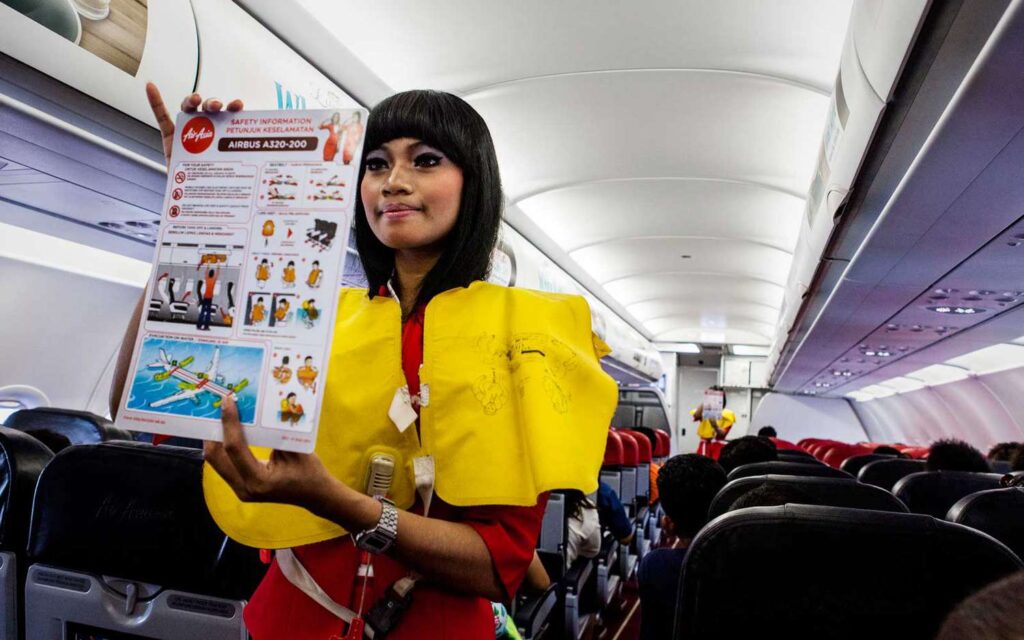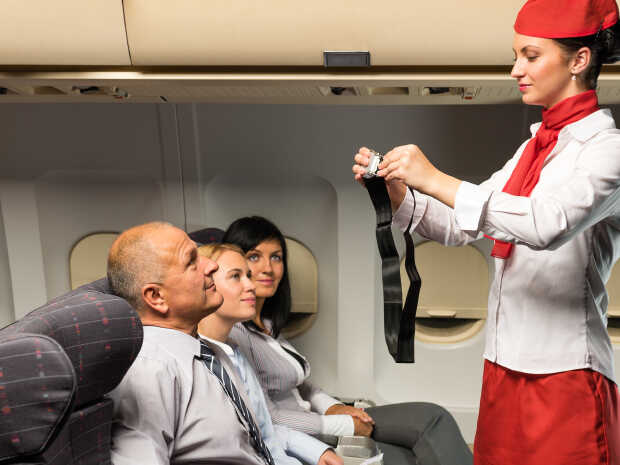It is crucial to be ready for emergencies on board an airplane because doing so considerably improves your chances of saving lives and minimizing injuries.
Several factors make planning crucial in these circumstances, including the following:
Fast and Effective Evacuation: Knowing the aircraft’s safety features, evacuation procedures, and the locations of emergency exits will help you save time in the case of an emergency landing or evacuation. Knowing what to do and where to go increases the likelihood that passengers will evacuate effectively, lowering the risk of injury and ensuring a quicker response from emergency services.
Proper Use of Safety Equipment: The right way to use safety equipment is crucial if there is a need to use life jackets, oxygen masks, seat belts, or evacuation slides during a plane crash or emergency. Travelers who are aware of these safety precautions can take prompt, decisive action to safeguard themselves and assist others.
Mental readiness: In times of stress, having a plan in place and being aware of potential emergency circumstances can help passengers remain composed and make sane judgments. Panic and terror can impair judgment, prevent crew member cooperation, and possibly even increase the danger of damage.
Emergency Communication: Understanding how to communicate with the flight crew in an emergency can be crucial. Coordination and the facilitation of a more efficient reaction can be aided by adhering to their orders, remaining aware of the circumstance, and providing pertinent information to the crew.
Medical Emergencies: Though they are uncommon, medical crises might happen while you’re flying. In order to provide immediate treatment to people in need until the aircraft reaches a medical facility, being prepared with fundamental first aid knowledge or having medical specialists on board can be crucial.
Personal Emergency Kit: During an aircraft emergency, having a small emergency kit on hand that contains necessary supplies like a flashlight, a whistle, a basic first aid kit, and extra medication (if needed) might be helpful. While they wait for assistance, these things can help people satisfy their urgent requirements.
Environmental Awareness: Being aware of your surroundings and paying attention to safety briefings and safety cards can help you in an emergency by giving you access to important information.
This entails being aware of the closest exits, comprehending emergency lighting and signage, and identifying potential risks that could obstruct evacuation.
Passengers can contribute to their personal safety and the safety of those on board by being prepared and aware about emergency situations on aircraft.
It is significant to note that in order to guarantee that passengers are suitably prepared for crises, airlines and regulatory bodies give considerable safety information and resources.
Tip 1: Fasten Your Seatbelt

It is crucial to always wear your seatbelt when flying for a number of reasons.
- Turbulence: One of the most frequent reasons for injury during flights is turbulence. Unexpected turbulence can happen at any time, even on flights that are often uneventful. Wearing a seat belt keeps you firmly in place and lowers your risk of hurting yourself by rolling around in the cabin. This keeps you steady and prevents you from jerking or possibly bumping your head onto the overhead bins or other travelers.
- Sudden maneuvers or crises: A seat belt is necessary in the event of sudden maneuvers or emergencies, such as abrupt changes in altitude or unanticipated evasive actions, to keep you confined to your seat. Because doing so could cause significant injury or impede the evacuation process, it safeguards you from being flung forward or out of your seat.
- Unforeseen circumstances: Traveling by air includes a variety of unforeseeable events, like rapid changes in the weather, heavy flight traffic, or technical issues. Wearing a seat belt enhances your safety throughout the procedure, lowering the chance of injury during unforeseen events such as the pilot having to make an emergency landing or divert the aircraft to a different airport. going to go.
- Compliance with regulations: It’s crucial to remember that, even when the seat belt indicator is off, passengers are still required to fasten their seat belts per airline regulations and crew instructions whenever they are seated. Airlines may be punished or even banned for breaking the rules, which might pose severe safety risks.
- Providing a Good Example: When you buckle up, you provide a positive example for other passengers, especially young children. It motivates others to emulate it and prioritize their own safety while fostering a culture of safety in aircraft.
Recall that turbulence or unanticipated circumstances might appear at any time during a flight, even during takeoff and landing. Hence, regardless of the flight status or duration, it is essential to buckle up anytime you are seated.
Tip 2: Pay Attention to the Safety Briefing

For a number of key reasons, paying close attention to the safety recommendations provided by flight attendants is crucial:
- Emergency Preparedness: The safety instructions given by flight attendants are intended to prepare passengers for potential emergencies and safeguard their safety in such circumstances. They offer details on significant safety features, emergency protocols, and the location of emergency exits. Passengers can better prepare for emergencies by attentively listening to these instructions, which will help them respond quickly and increase their chances of survival.
- Knowledge of the configuration of the aircraft: Flight attendants frequently share information about the layout of the aircraft, such as the locations of emergency exits, evacuation slides, and life rafts. Passengers can better comprehend the nearest and easiest exit to their seats by actively listening to this information. This knowledge is important during an emergency evacuation when time is of the essence and visibility may be poor.
- Use of safety equipment correctly: During the safety briefing, flight attendants demonstrate how to properly utilize safety equipment such as seat belts, oxygen masks, and life jackets. Passengers can better comprehend how to operate these gadgets and make the most of their efficiency in an emergency by paying close attention while listening.
- Special Procedures and Needs: Flight attendants may provide specific instructions for passengers traveling with infants, young children, or individuals with special needs. Active listening helps passengers understand any additional procedures or considerations needed to ensure the safety and well-being of themselves and those under their care.
- Personal Responsibility: Actively listening to safety instructions shows personal commitment to one’s safety and the safety of others onboard. By actively attending safety briefings, passengers accept their responsibility to follow safety protocols, cooperate with crew members, and contribute to the overall safety culture on board the aircraft.
- Updates and Changes: Flight attendants may also provide updates or changes to safety procedures based on specific circumstances or regulations. By actively listening, passengers stay informed and aware of any amendments to safety instructions or protocols, ensuring they are up-to-date and prepared.
Remember, flight attendants are highly trained professionals who make passenger safety a priority. Actively listening to their instructions shows respect, care, and a willingness to prioritize your safety and that of fellow travelers.
Tip 3: Follow Instructions from the Flight Crew

The flight crew is crucial to maintaining both the safety and well-being of the passengers and the aircraft during an emergency. His main duties are as follows:
- Communication: The flight crew acts as the primary conduit for information concerning the emergency situation, including its type, location, and purposes, between the aircraft and air traffic control. Also, they interact with passengers and provide guidance and assurance.
- Making decisions: The flight crew is prepared to immediately analyze the situation and make important choices. They evaluate the problem’s seriousness, choose the best course of action, and carry out emergency procedures as necessary.
- Emergency Procedures: The flight crew is knowledgeable about the emergency procedures unique to their aircraft type. When dealing with various scenarios, such as engine failure, cabin pressure loss, fire, or other faults, they adhere to set processes. These protocols cover things like starting an emergency landing, securing the aircraft, and deploying emergency gear.
- Pilot Flying and Pilot Monitoring: A Pilot Flying (PF) and a Pilot Monitoring often make up the flying crew (PM). The physical control of the aircraft and the performance of the necessary maneuvers are the PF’s responsibility. The PM supports the PF by keeping an eye on the machinery, communicating, and carrying out other tasks as required. Both pilots cooperate to properly manage a situation in an emergency.
- Coordination and Leadership: To effectively handle emergencies, the flight crew maintains coordination and teamwork. They distribute responsibilities, allocate jobs, and make sure there is clear communication within the crew as a whole as well as with other crew members like flight attendants.
- Passenger Management: The aircraft crew has received training in passenger management during emergencies. They uphold order, brief passengers on emergency protocols, and, if required, help with the evacuation. They put travelers’ safety and well-being first while offering assurance and support.
- Post-Emergency Actions: After an emergency has been put under control, the flight crew evaluates the state of the aircraft and its systems. They could have to make further choices, such as choosing a different airport to divert to or starting an emergency landing procedure.
It is crucial to remember that exact duties and procedures may change depending on the airline, the type of aircraft, and the emergency’s specifics. To make sure they are equipped to handle various emergency scenarios successfully, flight crew members go through intensive training and are periodically evaluated.
Tip 4: Know the Brace Position
During a crash landing or emergency landing, passengers are required to assume a precise stance known as the brace position. Its goal is to lessen the possibility of harm and raise the likelihood of survival under such circumstances. The brace position is intended to help absorb impact forces and protect critical body parts.
The typical brace posture is described as follows:
- Seat: Keep your seatbelt tight and remain seated when driving. Seatbelts aid in keeping you confined in the event of an accident.
- Legs: From your seated position, move your feet forward so that they are flat on the ground. To create a solid foundation, space them about shoulder-width apart.
- Knees: With your upper body as near to your thighs as possible, lean forward at the waist. Your chest and thighs should ideally be touching.
- Head: To prevent hitting any hard surfaces, lower your head as far as you can. This serves as a “cushion” for your body, keeping your head within of this secure space.
- Hands: Stack your hands one atop the other above your head. You should arrange your hands so that they will shield your head and neck from any flying debris or objects.
Many objectives are achieved with the brace position:
- Controls the body: By buckling your seatbelt and adopting a bracing position, you are placing your body in a more controlled posture and decreasing the chance that you may be tossed around the cabin following an accident.
- Protects vital areas: The location of the head and hands helps shield the upper body and other key areas from probable contact and debris. Vulnerable areas protected include the head, neck, and upper body.
- Reduces whiplash injuries: The brace position lowers the risk of whiplash injuries that might occur from rapid deceleration by bringing the head closer to the knees and slouching forward.
- Increases Survival Space: Increasing the “survival space” around you can help protect you from being hurt by adjacent items or structures, provided that the brace position enables a more compact body posture. The threat decreases.
It is crucial to adhere to the flight crew’s directions about brace position because certain aspects may change depending on the kind of aircraft and the airline’s safety regulations in the event of a crash landing or other emergency, adopting the brace position can improve survival odds and lower the danger of injuries.
Tip 5: Stay Low and Exit Quickly

Staying down to avoid smoke during evacuation is important for personal safety. Smoke generated during a fire or emergency can be extremely dangerous due to its toxic composition, low visibility and high temperature. Here’s why staying short is important:
- Reduction in smoke inhalation: Smoke contains harmful gases, particles and chemicals that can cause respiratory distress, suffocation or even loss of consciousness. By staying low to the ground, you can reduce your exposure to the densest and most toxic layers of smoke that rise toward the ceiling. Lower levels usually have higher oxygen content and relatively less smoke, providing a safe breathing zone.
- Enhanced Visibility: Smoke fills the higher portions of the room or space and rises, decreasing visibility. Although smoke is typically thinner closer to the ground, staying low will allow you to preserve better visibility. You can then find exits, discover barriers or dangers hidden by smoke, and follow the evacuation route more successfully.
- Cool temperature: While a fire burns, heat and hot gases rise, warming the upper layers of the area more than the lower ones. Staying at a lower temperature may help you avoid being exposed to higher temperatures, which may help lessen your chance of suffering burns or other heat-related injuries.
Keep in mind the following advice to properly keep low and lower your risk of smoke inhalation during evacuation:
- Keep your body close to the ground; if necessary, stoop or crawl. To avoid the heavy smoke and hazardous fumes, keep your head down.
- Put your mouth and nose covered. Cover your mouth and nose with a moist towel, piece of cloth, or other covering. This may offer some measure of defense against irritants and smoke particles.
- Remain concentrated and move in a controlled manner in the direction of the closest exit. Go quickly. Avoid panicking since it impairs your capacity for clear thinking and sensible action.
- Pay heed to orders from the aircraft crew, emergency personnel, or any available emergency alerts and follow them when it comes to evacuation. They will advise you on the most secure evacuation route and give you crucial information to guarantee your safety.
Remember to ensure that the door is hot before opening it if you come across one during the evacuation. It is safe to take a different route or wait until aid arrives in a safe place if heat is sensed, as this could mean there is fire on the other side.’
Remaining down during an evacuation will significantly improve your chances of leaving a smoke-filled area safely and lower the dangers of smoke inhalation.

